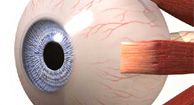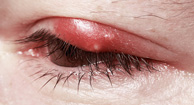56 Causes of Eye Disorders
 See How the Eye Works
See How the Eye Works

Nearsightedness (myopia)

Farsightedness

Astigmatism

Presbyopia

Conjunctivitis (pink eye)

Allergic conjunctivitis

Foreign object in the eye

Cataract

Eye floaters

Corneal abrasion

Eyelid inflammation (blepharitis)

Eye redness

Dry eyes

Visual disturbances

External eyelid stye (hordeolum externum)

Watery eyes

Eye pain

Eyelid turned in (entropion)

Eye burning accompanied by itching and discharge

Eyelid twitch

Glaucoma

Eye and vision development

Dry eye syndrome

Black eye

Bleeding under conjunctiva (subconjunctival hemmorhage)

Retinal detachment

Lazy eye

Pterygium

Diabetic retinopathy

Night blindness

Eye emergencies

Visual impairment

Hypertensive retinopathy

Strabismus

Age-related macular degeneration (AMD)

Bulging eyes

Color blindness

Blindness

Uveitis

Hazy vision

Scleritis

Corneal ulcer

Photophobia

Hyphema

Cone-rod dystrophy

Ophthalmoplegia

Ocular migraines

Sarcoidosis

Retinitis pigmentosa

Retinal vascular occlusion

Problems with eyes and ears in the premature baby

Optic neuritis

Myasthenia gravis

Usher syndrome

Coloboma

Adie's pupil
 See How the Eye Works
See How the Eye Works
Nearsightedness (myopia)

Farsightedness

Astigmatism

Presbyopia

Conjunctivitis (pink eye)

Allergic conjunctivitis

Foreign object in the eye

Cataract

Eye floaters

Corneal abrasion

Eyelid inflammation (blepharitis)

Eye redness

Dry eyes

Visual disturbances

External eyelid stye (hordeolum externum)

Watery eyes

Eye pain

Eyelid turned in (entropion)

Eye burning accompanied by itching and discharge

Eyelid twitch

Glaucoma

Eye and vision development

Dry eye syndrome

Black eye

Bleeding under conjunctiva (subconjunctival hemmorhage)

Retinal detachment

Lazy eye

Pterygium

Diabetic retinopathy

Night blindness

Eye emergencies

Visual impairment

Hypertensive retinopathy

Strabismus

Age-related macular degeneration (AMD)

Bulging eyes

Color blindness

Blindness

Uveitis

Hazy vision

Scleritis

Corneal ulcer

Photophobia

Hyphema

Cone-rod dystrophy

Ophthalmoplegia

Ocular migraines

Sarcoidosis

Retinitis pigmentosa

Retinal vascular occlusion

Problems with eyes and ears in the premature baby

Optic neuritis

Myasthenia gravis

Usher syndrome

Coloboma

Adie's pupil
The eye is an amazingly complex organ that brings the outside world to life.
Nearsightedness, or myopia, is a very common condition in which nearby objects are visible but faraway objects are out of focus and difficult to see.
Farsightedness, or hyperopia, is a common vision impairment in which you are able to see things that are far away, but have trouble seeing things that are up close.
Astigmatism is a common vision problem that causes distorted, fuzzy, or blurry vision as a result of an irregular curve in the eye's lens or cornea.
Presbyopia causes people's eyes to be unable to focus as quickly on close-up objects. It naturally affects everyone's eyes as they age.
Conjunctivitis, or "pink eye," is an infection or swelling in the eye area that causes inflammation of the conjunctiva, giving the eye a red or pink color.
Allergic conjunctivitis is when exposure to allergens (such as mold spores or pollen) cause your eyes to become watery, red, and itchy.
A foreign object in the eye is anything that enters the eye from outside the body and does not belong there. It causes immediate symptoms, but may or may not be serious, depending on the object.
Cataracts are dense, cloudy areas that slowly form in the lens of the eye. They are common in older people, but can also be present at birth or caused by medications, disease, trauma, or radiation.
Specks and strings may appear in your field of vision. These are called eye floaters, and are most commonly caused by age-related changes to the eye.
A minor scratch to the eye's cornea, which the thin layer that covers the iris and pupil, is called a corneal abrasion. It can be caused by dust, contact lenses, or other foreign objects, and can sometimes develop into a serious eye condition.
Blepharitis is inflammation of the eyelash follicles. Its cause is unclear, but allergies, mites, dandruff, and certain medications may increase the likelihood of this form of inflammation.
Eye redness occurs when the vessels of the eye become irritated or swollen. It can occur due to dry air, dust, allergies, or as a result of a more serious condition.
When the eyes do not produce enough tears, this results in dry eyes. It can be caused by environmental factors, dry eye syndrome, medications, and other causes as well.
When a condition or disorder temporarily or permanently interferes with the normal sense of sight, this is called a visual disturbance.
A red, painful bump or inflamed area on the eyelid is called a stye or hordeolum. It's typically caused by bacterial infection of the sebaceous glands at the base of the eyelashes.
If the eyes produce too many tears, the tear ducts become overwhelmed and the eyes become watery. Watery eyes can be caused by strong emotions or laughter, weather, or a range of different conditions.
Eye pain, or ophthalmalgia, is a common form of discomfort that can occur inside the eye (orbital pain) or on the surface of the eye (ocular pain). It is rarely a result of a serious condition, and usually resolves on its own without treatment.
Entropion is when your eyelid rotates inward, causing irritation, abrasion, and redness. It is common in older people, but it can also be congenital or caused by chemical burns, tracoma, or herpes zoster ophthalmicus.
Eye burning accompanied by discharge and/or itching is usually a sign of infection, and should be looked at by a doctor immediately. It can also be a sign of a foreign body in the eye or an injury to the eye.
An eyelid twitch, or blepharospasm, is when the eyelid muscles spasm involuntarily and repeatedly. These are usually minor, but can become chronic in some cases, or can accompany serious brain and nerve disorders.
Glaucoma refers to a number of diseases that damage the optic nerve and can lead to vision loss. It is usually caused by abnormally high pressure inside the eye.
The human visual system is very complex and takes a while to fully develop. This system's development is a very important health consideration.
Dry eye syndrome is a condition in which the eyes are unable to produce a sufficient amount of tears, which can lead to irritation and redness in the eyes. It has a number of potential causes, including medications, allergies, and hormone replacement therapy.
A black eye is when the capillaries beneath the skin around the eyes have broken, blood enters the surrounding tissue and discolors it, giving the appearance of bruising.
If blood has collected under the conjunctiva, the transparent tissue that covers the white of the eye, this is called a subconjunctival hemorrhage. This is not a dangerous condition, and tends to go away by itself within a few weeks.
When the retina separates from the back of the eye, this is known as retinal detachment. It is a medical emergency that can cause partial or total vision loss.
When the brain does not properly acknowledge the information it receives from one of your eyes, this results in a lazy eye, or "amblyopia." This condition normally occurs only in children and usually affects just one eye, which may "wander" around. It can cause serious vision damage if it goes untreated.
Pterygium is a benign, noncancerous growth that develops on the mucous membrane on the white part of the eye. Although they usually don't need treatment, they can be removed if they cause vision problems.
Diabetic retinopathy causes vision problems as a result of type 1 or 2 diabetes, which can damage the blood vessels of the eye's retina. It may start as minor visual problems but it can eventually cause blindness.
Night blindness is a form of vision impairment that causes affected individuals to have difficulty seeing in the dark or in dim lighting. It is usually a result of eye conditions such as nearsightedness or cataracts.
An eye emergency is when chemicals or a foreign object gets in the eye, or an injury affects the eye area. Emergencies require immediate medical attention to help prevent permanent vision damage.
If glasses or contact lenses cannot correct someone's vision, this is known as a visual impairment. Impairments range from low vision and color blindness to total blindness.
Hypertensive retinopathy is a condition in which high blood pressure causes vision problems by limiting the retina's function and increasing pressure on the optic nerve.
Strabismus, or "crossed eyes," causes the eyes to not line up in the same direction. It tends to develop in children who are very young, and is often treatable.
Macular degeneration is the most common form of vision loss in people age 50 or older. It occurs when the macula, an important part of the retina, becomes damaged.
Proptosis and exophthalmos, or bulging eyes, are when the eyes protrude out of their normal position. It can be caused by a number of different conditions, including Graves' disease, glaucoma, and leukemia.
Color blindness is an inherited or acquired condition in which the patient has difficulty telling apart certain colors or cannot see any colors at all. It is more common in men than in women.
Blindness is the inability to see anything, including light. It can be partial or complete, and can be caused by a number of different diseases, or be present at birth.
Swelling of the uvea, the middle layer of the eye, is called uveitis. It is often associated with infections or autoimmune diseases, and can cause blurry vision, eye pain, and floaters.
Hazy vision is a problem that makes it difficult to see clearly. It can be caused by a number of different factors.
Scleritis is severe inflammation of the sclera, the eye's outer protective layer. It usually causes pain, and can sometimes cause vision loss.
A corneal ulcer is a open sore that forms on the cornea, the clear layer on front of the eye. It is usually caused by infections but can also results from small eye injuries.
Photophobia, or light sensitivity, is when bright lights hurt your eyes. It can be associated with a number of conditions, ranging from minor to very serious.
A hyphema is a collection of blood in the eye, between the cornea and the iris. It is painful, and requires immediate medical attention.
Cone-rod dystrophy is an uncommon inherited condition that causes the cones and rods of the eye's retina to deteriorate over time, often leading to blindness.
Certain neurologic disorders can cause ophthalmoplegia, which is weakness or paralysis of muscles that control the eye's movement.
An ocular migraine, or migraine with aura, is a migraine that is accompanied by a visual disturbance.
Sarcoidosis causes granulomas, which are clumps of immune cells, to form in organs such as the eye. Symptoms of sarcoidosis in the eye include dry, itch eyes, discharge, burning sensation, and vision loss.
Retinitis pigmentosa is a group of conditions that are inherited and gradually bring about blindness. These conditions result to abnormal aspects of the retina, particularly the rods.
A retinal vascular occlusion is when a blockage or blood clot forms in the veins or arteries transporting blood to or from the retina. It can get in the way of the eye's ability to filter light properly, and can cause vision loss.
Certain eye problems can form in premature babies, including retinopathy of prematurity, nearsightedness (myopia), and lazy eye (strabismus).
Optic neuritis is a condition in which the optic nerve becomes inflamed and causes vision loss, usually in one eye. Vision can return after the inflammation goes away.
Myasthenia gravis is a neuromusclar disorder. It results in weakness of the skeletal muscles, and can cause double vision and drooping of the eyelid.
Usher syndrome is an inherited condition that causes both hearing loss and retinitis pigmentosa, a type of vision loss that gradually causes blindness.
Coloboma is a condition present at birth in which a part of the eye's structure is missing. Usually the missing part is the iris, retina, or optic nerve.
Adie's pupil, or Adie syndrome, is a rare neurological condition that causes one eye's pupil to be bigger than the other.
No comments:
Post a Comment